With Disney’s Tomorrowland now released in theaters and Disneyland’s 60th anniversary celebration officially underway, Quest For The Vault Disney is taking a Disney Decade by Decade look at the Disneyland area of the future, Tomorrowland. Herein lies a chronological look at every attraction that has ever entered into Disneyland, beginning fittingly with Opening Day.
A history of the land before we begin. Tomorowland was the last of the lands to begin construction in earnest in Anaheim.In conception, Tomorrowland as set in the distant future of 1986 (chosen for the next fly-by of Haley’s Comet). Designers struggled to create architecture of the future, let alone a futuristic landscape. Budget constraints did not make the job easier, and the land would end up opening with empty show buildings with the promise of future attractions to come.
Although the entire area was not considered “complete” on opening day, may attractions were. A quick rundown of the attractions of July 17, 1955 version of Tomorrowland:
At the entrance of Tomorrowland stood the Clock of the World. Park guests were able to walk up to a 17 foot tall tower which had a world map projected on it. A set of 24 numbers would rotate counterclockwise around the map, aligning with the proper hour for each area of the world. A digital display showed the minute display for park guests. The clock would last until 1966.
To the left of the Clock of the World stood one of the main show buildings of Tomorrowland, containing Space Station X-1, also known as a Satellite View of the World. This was more painting than attraction, giving park guests the chance to stand on a platform and look down on the earth from “90 miles above.” A three minute presentation took place, with the room rotating around the map. This attraction took an A Ticket to experience it. The platform would last until 1960.
At opening day, the heart of Tomorrowland was the Court of Honor, which was a eight-point star-shaped flower box. Each of the points contained six flag poles, which flew one of the 48 state flags of the nation. Court of Honor would be short lived in its opening day location, as it would be relocated and renamed in 1956.
Moving counterclockwise from the Court of Honor comes the first ride attraction in this tour, Autopia. The original version of the ride was quite a bit different from the version known today. To begin, no center rail was on the miniature highway, meaning the Mach 1 model cars were able to drive side by side, as well as pass other drivers. As well, the Mach 1 cars were not very sturdy. While the car bodies were modeled after Porches and Ferraris, the frames were only made out of aluminum, the bumpers of fiberglass. Due to collisions and hitting the side railings, 38 of the 40 cars were inoperable by the end of opening day. Changes would come to the cars in coming weeks and years, and the ride still exists to this day.
Next on our tour comes an icon of Opening Day, the Moonliner. Sponsored at first by TWA, this 76 foot tower of a rocket stood in Tomorrowland for guests to walk past, but it as a display only. It was the tallest structure in the park, eight feet taller than Sleeping Beauty’s Castle. It stood next the entrance to Flight to the Moon (see Part 2). It would stand in its original display place until 1967.
Our last Opening Day Tomorrowland Attraction stood in the show building near the Main Street Hub entrance, the Hall of Chemistry. The first of four Monsanto sponsored attractions, it was a free walk through exhibit teaching the benefits of chemical engineering. The hall was decorated with test tubes, wall displayed and a metaphorical arm reaching across the ceiling. This exhibit would last until 1966.
Even though the Opening Day ceremonies had concluded and the larger than invited park crowds had died down for the day, construction workers were still working to make Tomorrowland more complete than before. In just a few hours time, the next attraction to open to the public would debut.
Note: In Part 1 we looked at Disneyland’s Tomorrowland as it stood on Opening Day, July 17, 1955. Now we look at the evolution and development of the land from July 18, 1955 through the end of calendar year 1964.
Monday, July 18, 1955 would be the first operating day for Circarama, which would later be known as Circle-Vision. Operating in a show building at the entrance of Tomorrowland, A Tour of the West took standing guests on a 12 minute scenic drive from Beverly Hills to Monument Valley. The film was shot with 11 16mm cameras mounted on top of a (presenting sponsor) American Motors car. As the name suggests, the movie was presented on a 360 degree screen, which drew in the park guests (it was also a free admission attraction, no ticket required). The interior of the theater was decorated with American Motor cars and Kelvinator refrigerators, both sponsors of the attraction. A Tour of the West would until 1960, when it was replaced by the 16 minute America the Beautiful. This version included aerial footage of the nation. At this time, Bell Telephone Systems became the sole presenting sponsor of Circarama. The name would be changed in 1964 to Circle-Vision. More name changes would come in the future, and the attraction would run until 1997.
Next in the chronological tour of Tomorrowland comes the August 3, 1955 opening of the 20,000 Leagues Under the Sea Exhibit. One of the last attractions to be thought of for Opening Day, the movie-inspired exhibit was not ready for opening day, and for several weeks later. Instead of looking towards the future, the foremost stage building of Tomorrowland contained the giant squid and other items from the still popular 1954 movie starting Kirk Douglas. When it opened, it offered park guests a first time view of movie props. While the intended temporary attraction lasted for 11 years, Captain Nemo’s pipe organ lives on at the Haunted Mansion.
Also opening in August was the World Beneath Us Exhibit sponsored by the Richfield Oil Company. Housed in the same building as Circarama, this free exhibit was a promotion for the oil company, showing park guests to see how oil was formed, using animated cavemen and dinosaurs showing the process (in faster than real time). The end of the exhibit featured a Los Angeles Basin map highlighting which area were rich in oil. The exhibit would not last, closing its doors in 1959.
Between the World Beneath Us Exhibit and the Tomorrowland Lagoon stood the counter service restaurant Yacht Club. Decorated with nautical pennants and providing an overhanging roof to shade park guests, the Yacht Club would only stand for one year, before moving 75 feet away and being renamed the Yacht Bar. The Yacht Bar itself would last until 1966.
Also for eating convenience, the Space Bar opened in the summer of 1955 near the Moonliner Rocket. Inspired by the Automats of New York, this was another counter service restaurant that also contained one wall of vending machines. A remodel in 1961 would see the vending machines taken out and more seating, along with a covered patio was added. This remodel would not help the Space Bar last, as it was closed down in 1966.
August 16, 1956 saw the maiden voyage of Phantom Boats in the Tomorrowland Lagoon. Designed with no track and no guard rails, park guests were allowed to travel through the lagoon at slow speeds. With no track, these boats would often stall in the middle of the lagoon, causing Disney to staff each of the 14 vessels with a Cast Member to help restart the boat when it happened. These fiberglass boats ended up being more troublesome than original Autopia cars, breaking down and needing maintenance done on a near nightly basis. As a result, the attraction closed in January 1956, making it the first attraction to be removed from the park. However, they would reopen in the summer to keep the lagoon from being empty. Mechanical issues surfaced again, and the Phantom Boats closed permanently that October.
As the opening summer came to a close and the autumn began, Tomorrowland continued to grow and finish its initial completion. September 4 saw opening of Hobbyland, Located near Flight to the Moon, this was a retail area, which consisted of, surprisingly, hobby items such as model kits. One reason Hobbyland did well was the nearby Flight Circle, a chain linked fenced area that was used to demonstration powered boats, cars and model planes. While the planes were loud and could be heard throughout the park, the exhibit was popular and lasted until January 1966, when but the Flight Circle and Hobbyland closed.
October 1 1955 saw the opening of the Art Corner next to the Satellite View of America. Inside this store was art supplies, Disneyland postcard, Disney art work (this includes many inexpensive, and now rare, animation cels). Guests could also have portraits drawn by Disney animators, which could be shipped home for the guests. The Art corner would also last until 1966.
The Hall of Aluminum Fame was the last Tomorrowland attraction of 1955 to open came in December, an exhibit sponsored by Kaiser Aluminum & Chemical Company. The exhibit was located inside the same building as Monsanto’s Hall of Chemistry. The entrance to the exhibit was a 40 aluminum cylinder telescope, which lead guests into a room lined with displays showing uses and history of aluminum. The centerpiece of the room was a “time sphere” showing images of man using and wearing aluminum. This display was not long for the park, as it would close in 1960.
The year 1956 began the same way 1955 ended, with an exhibit hall opening to fill space in Tomorrowland. The American Dairy Association Exhibit opened on January 21, 1956 in the same show building as the 20,000 Leagues Under the Sea exhibit. Souvenir books from the period offered descriptions of “future techniques in production and distribution of dairy products.” Along with plastic cows watching television, park guests could visit the Dairy Bar inside the exhibit and enjoy a cold milk. The exhibit would last until September 1958.
A mere eight months after Disneyland opened brought about the first “shuffle” of locations, as the Court of Honor relocated from the back of Tomorrowland and emerged as the Avenue of the Flags, which ran 150 feet from the park Hub to the entrance of Tomorrowland. The Avenue of the Flags contained 49 flag poles (later expanded to 51), and the flag of each state was flown in chronological order of admittance to the nation. At the end of the Avenue of the Flags flew Old Glory. The addition of the flags ended up blocking the Clock of the World from view while walking down Main Street USA. However, both would remain until 1966.
The cause of this shuffle was the Astro-Jets, which opened where the Court of Honor once stood on March 26, 1956. This classic spin ride, the first new ride attraction to open in Disneyland since opening day, consisted of 12 rockets that would whirl around near center of Tomorrowland. More detailing to the white jets with red or blue trim is what made this attraction stand out from the standard carnival spin attraction. The name would be changed in 1964 to Tomorrowland Jets, however this incarnation would close and be relocated in 1967.
The next “moving” attraction would open just weeks later. The Bathroom of Tomorrow had its premier on April 5, 1956, following a ceremony with Walt Disney and other dignitaries turning the water on to this facility. Housed in the same building as the Hall of Chemistry and Hall of Aluminum Fame, this 20 foot wide room showed guests different bathroom fixtures in yellow (some plated in 24 karat gold). The exhibit, presented by Crane Plumbing Company, would last until 1960.
The next moving attraction to open in Tomorrowland required little space at all. Carrying park guests between Fantasyland and Tomorrowland, the Skyway opened on June 23, 1956. The Tomorrowland entrance to the quarter-mile attraction stood near the Autopia attraction, and would last for 38 years before closing in 1994.
After the opening of the Skyway, it would be nearly a year before the next Tomorrowland attraction would open.June 12, 1957 saw the home warming for House of the Future, a plastic structure sponsored Monsanto. The three bedroom two bath house stood on a 256 square foot platform surrounded by a garden and swimming pool, which was part of the cooling system for the house. 20 million guests visited the House of the Future before it closed in 1967.
A train would be Walt’s next addition to Tomorrowland, as the Viewliner train would open on June 26, 1957. Like the Skyway, there was a station is Fantasyland and a station in Tomorrowland, but the color-coded lines only stop at one of the two stations. The red cars, named after celestial bodies, stopped at the Tomorrowland station before taking a tour through the area, looping around both lands, and around two under construction attractions, Matterhorn Mountain and the Submarine Voyage. It was due to yet another coming Tomorrowland attraction that would cause the Viewliner to close just fifteen months after it opened.
What was the attraction that would replace the Viewliner? The Tomorrowland station would be replaced by the loading platform for the Monorail, opened on June 14, 1959 as part of the first major expansion of Disneyland. which happened to focus in Tomorrowland (Matterhorn Mountain is considered Fantasyland and will be covered in a later series).Disney Legend Bob Gurr designed the Monorail cars, which design company Alweg had been running in Germany previously). 82 passengers rode on the initial incarnation of the Monorail, which ran from Tomorrowland station, around the lagoon, Autopia and Matterhorn Mountain before returning to Tomorrowland station. This eight-tenth of a mile would be expanded in 1961 to a length of 2.3 miles, taking park guests over the Disneyland parking lot to the Disneyland Hotel, where a second station had opened for hotel guests. This rail expansion also saw the introduction of the second generation of Monorail trains, called the Mach II. These trains had a fourth car, increasing capacity to 108 guests, and included a “bubble window” in the front car, allowing lucky guests a different view of the ride into and out of the park. The Monorail continues to operate to this day from Tomorrowland to Downtown Disney and back.
Also making their official debut at Disneyland on June 14, 1959 was the Submarine Voyage, promoted as “The world’s largest peacetime fleet.” They had soft opened about a week open, but were dedicated along with the Monorail and Matterhorn Mountain on June 14. Truthfully, the subs weren’t subs, never submerged under the Tomorrowland Lagoon, and unlike the Phantom Boats that ran in the lagoon previously, these vessels were on a track. On the nine minute voyage around the lagoon guest would see mechanical fish, the ruins of Atlantis as well as artificial mermaids. Dual sets were built so guests on each side of the sub would see the exact same thing at the same moment. The subs would run until 1998, but would eventually reemerge years later. To help celebrate the dedication of the Submarine Voyage, eight “real” mermaids waved to park guests from the rocks in Tomorrowland Lagoon. After their one day appearance, they would swim away until 1965, when they would return for the summer season.
As we enter into the 1960s, Tomorrowland continued to evolve. February 17, 1960 saw the closing of opening day attraction Space Station X-1. The Art of Animation would take its place next to Circarama on May 28 of the same year. While seemingly out of place in Tomorrowland, the Art of Animation gave guests a chance to learn about the animation process, using the 1959 Sleeping Beauty as an example. Of course, it was also a means to promote the movie. Guests could look at the exhibits, or sit back in the plastic chairs and rest for a few minutes. The exhibit would last until 1966.
Also in 1960, Bell Telephone Systems became the presenting sponsor of Circarama, and a remodel of the pre- and post-show areas was done. This remodel included the introduction of Bell Telephone Systems Phone Exhibits, which offered park guests a look into the future of phone technology. Different displays showed off the emerging long distance calling technology, with a stopwatch showing guests how long it would take a Bell Telephone representative to place a long distance call. Phone technology proved to be popular in Tomorrowland, and the exhibits would remain until Bell Telephone Systems ended their sponsorship of Circarama in 1982.
The Hall of Aluminum Hall of Fame and the Bathroom of Tomorrow both left Disneyland in 1960, in their place in the show building came Fun Fotos. A simple premise to show off a new technology, guests would stand in front of painted Disneyland images and have their picture taken. After watching the photo develop in front of their eyes, guests could then purchase the souvenir. This popular exhibit would last until 1965, when the space was needed for a remodel.
The next expansion of Tomorrowland would see land behind the Fun Fotos building being used, as the Flying Saucers landed on August 1, 1961 next to Rocket to the Moon. Guests would climb into one of the 16 saucers and over a motorized board that shot up jets of air (when they worked). While a fun and popular attraction, the mechanics of the ride failed to cooperate, and the ride was down as often as it was running. The Flying Saucers left the park in 1966; they were reincarnated into Disney’s California Adventure in 2012 as Luigi’s Flying Tires, where it again lasted for a short period of time, having closed down earlier this year.
Following the addition of the Flying Saucers construction slowed around Disneyland. Walt and the Imagineers shifted their focus to the 1964-65 New York World’s Fair. In order to gauge interest in the attractions Disney was working on, and to give a preview of attractions that would be coming to the park once the fair ended, the New York World’s Fair Exhibit opened in 1963 inside the show building that previously held the Dairy Bar. While the full attractions were not shown, guests were able to catch glimpses and previews were presented. The Ford Motor company partnered with Disney to create Wonder Rotunda’s Magic Skyway; its ride vehicles would later become the PeopleMover, and the dinosaurs in the attractions would appear in the Primeval World Diorama. General Electric demonstrated Progressland, later known as the Carousel of Progress. Pepsi-Cola previewed It’s a Small World, while the state of Illinois showed off Great Moments with Mr. Lincoln, which would later appear on Main Street USA in the Opera House. Due to needing to be in New York for the fair, the exhibit ended in 1964.
The last Tomorrowland addition to enter during this decade long tour is the Premiere Shop. While not the largest merchandise shop in Tomorrowland, it was initially unique for its selection of California and sports themed merchandise. Located in the same building as the Art Corner, it would remain open until 2005, when it would be remodeled and renamed to match an attraction landing next door to it.
Tomorrowland actually saw very little done in 1965 for its tenth anniversary. Disney’s Imagineers were hard at work in other areas of the park, such as constructing New Orleans Square on the west side of the park. As well, Walt, when his health would allow it, was focusing attention on other projects, such as The Florida Project and abandoned Mineral King project. Additionally, plans were being set forth for the future expansion of the Tomorrowland area. As such, 1965 saw the addition of one “attraction” only, the third Monsanto funding exhibition, Fashions and Fabrics Through the Ages. Housed in the same building as the Bathroom of Tomorrow and Hall of Aluminum Fame, this textile-themed exhibit displayed women’s fashion from prehistoric animal skins to synthetic space wear of the future (which helped tie the attraction to the opening day Hall of Chemistry exhibit Monsanto was still sponsoring). The exhibit would run nine months, from March until December of 1965.
Following the closing of Fashions and Fabrics Through the Ages, a major remodel began in Tomorrowland. 1966 saw the saw the closure or removal of many attractions: Avenue of the Flags, Art of Animation, Art Corner, Yacht Club, Space Bar, Flying Saucers, Hobbyland, Flight Circle, and the 20000 Leagues Under the Sea Exhibit. While all these attractions left in the name of progress, the past did arrive in the land of the future through Primeval World. This addition, part of the Disneyland Railroad, debuted in Disneyland on July 1, 1966, after being on exhibit in the New York World’s Fair in 1963-64. The scene was inspired in part by the “Rite of Spring” sequence of Fantasia. Sadly, this would be the final Tomorrowland addition that Walt would experience before his passing on December 15, 1966.
As Walt Disney promised on opening day, Disneyland would never be completed, and so, even after his passing, construction continued on in the park. The result was a brand new Tomorrowland that was completed in 1967. In all, eleven additions to the land opened by the end of 1967.
As guests entered Tomorrowland from the Main Street USA Hub, they were would see the Corridor of Murals high on the exterior walls of Circle Vision 360 and Adventures through Inner Space. Created by Disney Legend Mary Blair, ceramic tile mosaics covered both building facades with a piece known as The Spirit of Creative Energies Among Children. The mural was covered in two phases, when each of the buildings it stood on was changed. The portion on Adventures Thru Inner Space was removed in 1987 to make way for artwork promoting Star Tours, while the mural over Circle Vision 360 was covered in 1998 to add a themed painting to the short lived Rocket Rods. When the Rocket Rod artwork was removed, it was discovered that the mural behind it had been damaged beyond repair.
When the new Tomorrowland debuted to the public on July 2, 1967, guests were greeted with several new options of where to turn their attention. First off, the second Tomorrowland attraction to have been at the New York’s World Fair, Carousel of Progress, sponsored by General Electric. Initially intended to be a walk through exhibit in the never realized Edison Square parallel to Main Street, this would instead become a rotating stage show. The Carousel Theater opened where the Space Bar stood previously. 240 guests would enter the theater and enjoy a period piece of audio-animatronic figures from the 1890s talking about how life was, then would be rotated to a new stage, circa 1920, with updated electronics, such as the electric fan and lights, as more guests would enter the first scene. Two more rotations would take guests to the 1940s (hearing aides are being used by grandma) and then the 1960s (color television with built in tape recorder). Afterwards, guests were directed into a second floor where they were able to examine a model of Progress City, which was Walt’s dream of an ideal society of the future. This model contained over 4000 building models and covered nearly 1/6 of an acre. Carousel of Progress, and its catchy theme “Great Big Beautiful Tomorrow” would only last in the part for six years, when it would be packed up and shipped to Walt Disney World in Florida.
In front of the Carousel Theater stood the loading platform for the PeopleMover, The PeopleMover itself was visible from all over Tomorrowland, as non-motorized vehicles would transport guest over an elevated motorized track. The ride, sponsored by Goodyear until 1981, was powered by rotating tired ever nine feet on the track that the vehicles would run over. As a result, the attraction was always moving, even in the loading and unloading areas, which consisted of a rotating platform moving at the same speed at the PeopleMover vehicles. The ride itself took guests across Tomorrowland, including through show buildings, and after 1977, a projected “Speed Tunnel.” The three-quarter mile attraction would last until 1995, when it would close for another Tomorrowland remodel; the track would remain for the short lived Rocket Rods attraction while the PeopleMover would be gone forever.
Guests not heading for the PeopleMover attraction were liking heading for what was on the loading platform’s roof, the Rocket Jets. Replacing the Astro-Jets that opened in 1956, the new incarnation resembled the Apollo spacecraft. The black and white spacecraft had defined noses with yellow headlights, and were attached to a central tower designed to resemble a Saturn launch tower used by NASA. Guests rode in a gantry elevator up to the loading area to board their Rocket Jet, which at their apex held passengers 70 above the Tomorrowland pavement. The Rocket Jets would orbit the PeopleMover loading platform until 1997, when the fleet was grounded for an area remodel.
The final addition of the Tomorrowland remodel to open on July 2 was the Tomorrowland Terrace. This forty foot structure initially appeared to be merely a display containing planters and pylons standing near the monorail loading platform. However, once the display started to rise out of the ground to become the roof of a stage, usually while a band was playing as the Terrace rose into place. The area was geared primarily towards teens, as the area in front of the stage was cleared of tables and chairs nightly to make room for dancing. The Tomorrowland Terrace has undergone a few remodels, and a temporary name change in 2001, becoming Club Buzz, but the Tomorrowland Terrace name returned in 2006. It currently is used for the Jedi Training Academy audience participation stage show.
A second bandstand opened in Tomorrowland this summer, the Tomorrowland Stage, that stood where the Flying Saucers landed previously. This stage was used for larger acts, while the Tomorrowland Terrace would be used for smaller acts. Though intended for musical acts, the Tomorrowland Stage is most known for showing a large-scale television broadcast, as Tomorrowland met today on July 20, 1969 when park guests watched the Apollo 11 moon landing live on an erected screen at the Tomorrowland Stage. The stage was rebuilt and renamed to Space Stage in 1977 to make room for Space Mountain. The stage would remain until 1986, when it was removed to make room for an indoor theater.
A remodel of Tomorrowland would not be complete without at least one shop being added to enhance the experience. Instead of several small shops, the Character Shop opened up in the building that previously housed the 20,000 Leagues Under the Sea exhibit and Fun Fotos displays. This was one of the largest shops in the park, and was located between two large venues (the almost open Adventures Thru Inner Space and the Tomorrowland Stage). In the back of the store, ten feet overhead, passed the PeopleMover vehicles. The in park shopping destination would last until 1986, when it would be replaced by another retail shop with a different name.
Just one month after the debut of the new Tomorrowland, another E-Ticket attraction opened in the area.The fourth and final Monsanto sponsored attraction, Adventures Thru Inner Space opened to the public on August 5, 1967. The ride was located in the first building upon entering Tomorrowland from Main Street USA, where the Hall of Aluminum Fame and Hall of Chemistry were previously housed.The attraction took guests and their “Atomobiles” and shrunk them with the Mighty Microscope so they could enter a snowflake and explore its chemical breakdown. Narrated by Paul Frees, this was the first attraction in the park to utilize the Omnimover ride system. This allowed the ride vehicle to remain in continuous motion during the loading and unloading process, as guests would step onto a moving platform (similar to the PeopleMover, which passed the loading queue from overhead). The Omnimover system also allowed the vehicle to turn and direct the guests towards the element they should be focusing their attention. The attraction would last until 1985, making space for a new ride experience.
Flight to the Moon would lift off on its maiden voyage one week later, on August 12, 1967. Standing in the same launching pad as its predecessor Rocket to the Moon, this simulation ride was similar to the previous but added a preboarding show, hosted by Audio-Animatronic Tom Morrow. This show gave a tour of Mission Control, including an attempted UFO landing (just a bird that seems to trip the over-sensitive alarms every day). The attraction, ranked as a D-Ticket, was not popular with park guests, who less than two years later were able to see a real flight to the moon happen from their home television and the Tomorrowland Stage. As a result, Flight to the Moon would be grounded in 1975 in preparation for a more ambitious space mission.
On December 1, 1967, the House of the Future closed its front door to park guests. After a quick yet careful deconstruction (careful as it was discovered a wrecking ball literally could not topple the plastic structure, crowbars and saws had to be used), the former housing pad was turned into Alpine Gardens, a virtually undeveloped rest area that provided photo opportunities of both Matterhorn Mountain and Sleeping Beauty’s Castle. The Alpine Garden would stand until 1995, when walls went up to develop another garden to open the following year.
After the massive remodel that was unveiled in 1967, Tomorrowland was left alone for the most part. The one exception, Carousel of Progress, which left for Florida in 1973. Its replacement in Disneyland was America Sings, a 24 minute patriotic celebration featuring 114 audio-animatronics. Utilizing the same rotating theater system used for Carousel of Progress, though in the opposite direction, with six different stops and musical renditions. All of the performers in the show were animals in traditional American costume for the renditions being performed. The show was hosted by Sam and Ollie, and eagle and owl, respectively; Sam voiced by Burl Ives. The attraction was popular through 1976 and the American Bicentennial, though attendance decreased soon after, though the show stayed open for many more years. In 1988 America Sings sang its last song, many animal performers were transported across the park to the new Splash Mountain, others were skinned and placed in the Star Tours queue, and the Carousel Theater was transformed to offices.
It’s worth noting 1975-84 was a slow period of growth in Tomorrowland. A major remodel had just taken place at the end of the 1960s to being Tomorrowland “up to date”, while other areas of the park were in need of attention. In Frontierland, a big thunderous mountain was forming in the late 1970s, while Fantasyland was going through a major remodel/redesign in the early 1980s, pulling resources away from Tomorrowland.
That’s not to say there were no additions to Tomorrowland. In fact, keeping with the theme of the area, everything that opened in this area was out of this world, so to speak. First to open, on March 21, 1975, was Mission To Mars. Launching from the same pad that once housed Rocket to the Moon and more recently Flight to the Moon, the Mission to Mars attraction was sponsored by McDonnell-Douglas, as Flight to the Moon had been. Guests would enter Mission Control, where they were greeted by audio-animatronic Mr. Johnson, a mechanical scientist, who gave a mission briefing before sending passengers to their seats in the flight theater. There, two large screens, one on the ceiling and one of the floor showed guests where they were headed and had come from, respectively as they headed to the Red Planet. Thanks to a hypersleep, the journey to Mars and back only took 15 minutes to complete. Despite low attendance figures to due to a waning of space exploration interest, the attraction lasted until 1992 before being shuttered.
Two years later Tomorrowland would see the arrival of a much more thrilling space attraction, and to prepare for it, the area where the Flying Saucers had previously existed was given a more intergalactic feel. First, in the same show building as Mission to Mars came Space Place, a large counter service restaurant for guests to grab some pizza or hot dogs. Space Place had the distinction of being the only eatery in Disneyland to serve both Coca-Cola and Pepsi Cola at the same time (Coke and Pepsi were both available in the park, just not in the same location, typically). The restaurant itself would serve guest until 1996, when it was closed to make room for a new, temporary attraction that was also taking the space used by Mission to Mars.
At the same time, another quick service eatery, Lunching Pad opened directly below the second story PeopleMover boarding area. Hot dogs, popcorn and sodas were available in this spot, which previously housed the Space Bar. While popular for a quick bit for guest in a hurry, the Lunching Pad would last until a major remodel of Tomorrowland in 1998.
As part of the 1977 expansion, a new technology opened in Tomorrowland on May 4. Starcade, a two story video game arcade (unrelated to World Championship Wrestling). Park guests, who had already paid an admission just to be in Disneyland, were able to plug quarters into the newest video games on the market. As the technologies improved, so did the games (and prices), including ski simulators and huge multi-player racing simulators. The Starcade is still open, though now it is only a one story arcade instead of two, with top of the line games costing $4 per play.
As exciting as a video arcade or some quick service food eateries are, the star of Tomorrowland’s 1977 expansion was Space Mountain, Disneyland’s first indoor roller coaster. It’s worth noting this Space Mountain not the first in the Disney Universe, as the coaster opened in Walt Disney World in 1975. Space Mountain would be the second of the Disneyland Mountain Range, behind Matterhorn, and two years prior to Big Thunder Mountain in Frontierland, and Splash Mountain in the yet-to-be-imagined Critter Country (1989). The attraction, built over the Flying Saucers flight path, soared 118 feet in the air, the second highest structure in the park (Matterhorn Mountain, at 147 feet is the highest). It was intended to draw park guest away from the competing theme parks in the area (Magic Mountain and Knott’s Berry Farm specfically). Mission accomplished, as more than ten million park guests came into the park to experience the “pitch black”, 30 mile per hour thrill ride. When the ride opened, it was a “silent” roller coaster, that is, the only sounds were the rocket shaped cars on the track and the screams of the riders. In 1997 enhancements were made to the cars, with speakers being installed to pipe in a music soundtrack. The attraction, with its 1800 guests per hour capacity, is still in operation today.
Just as the ten year period previous saw very few attractions opening, only four “attractions” opened in the period from 1985-94. A leadership change in the Walt Disney Company drew uncertainty of the park for a while, and there was construction being done in other areas of the park, with two new areas opening during this decade, Critter Country in the west (albeit more of a name change from Bear Country with a new thrill ride, Splash Mountain) and Mickey’s Toontown in the north, beyond the park berm. That being said, the additions that came to Tomorrowland ended up being some the most popular additions to enter Disneyland.
First to open, in May of 1986, came the Magic Eye Theater. As mentioned, a leadership change occurred in the Disney Company, and this was the first attraction completed under the watch of Michael Eisner. Just west of Space Mountain, the 525 seat theater began its operation by showing a 3-D film imported from Walt Disney World, Magic Journeys. This 16-minute film was scheduled for a four month run, after previously have 20 months of showing at the Space Stage. It was merely a place holder for the next 3-D film to run in the theater, still in post-production at the time. The Theater is still in use today, currently showing a preview of the movie Tomorrowland.
The four month, highly anticipated wait would end on September 18, when Captain EO made its Disneyland debut, six days after opening at Epcot in Disney World. A Hollywood A-List extravaganza, the film starred Michael Jackson in the title role, Anjelica Huston as the Supreme Ruler, directed by Francis Ford Coppola and was produced by George Lucas. While Magic Journeys had been the first 3-D film to be shown in Disneyland, previous theatrical attraction (Flight to the Moon, Mission to Mars) moving seats to enhance the guest experience. Captain EO utilized the same techniques, using seat vibrations to simulate impact as lasers hit the crew’s ship. After an eleven year run, the attraction wasn’t drawning the same level of crowds it previously had, as Jackson’s popularity dwindled and his legal issues soared. The 17 minute film closed on April 6, 1997. A tribute version of the show opened following Jackson’s death in 2010, on a temporary basis.
With a space Captain behind it, and another space attraction being built adjacent to it, the Character Shop was suddenly in need of a makeover. The doors shut on September 15, 1986, and it was reopened on November 21, 1986 as the Star Trader. Guests were greeted to the 5000 square foot retail shop with a neon-lit Mickey Mouse floating through space. Inside, toys, plush, shirts and hats were available for purchase, and a 30 foot X-Wing fighter hung overhead, giving a foreshadow of what was coming to the park in just six weeks. In preparation of the Star Wars attraction, toys and collector models were also available on opening day; now guests are able to build their own light saber. The store is still in operation, and quite popular, today.
On January 9, 1987 Tomorrowland premiered an attraction based on events that took place “a long time ago.” Star Tours, a shuttle service in the Star Wars galaxy. With a partnership with George Lucas, the attraction took the place of Adventures Thru Inner Space in the front show building of Tomorrowland. Making use of an enclosed flight simulator, 40 guests at a time would board StarSpeeder 3000s on a quick journey to the forest moon of Endor, with first time android pilot Rex, voiced by Paul Reubens. After taking a wrong turn, the StarSpeeder ended up in a galactic battle, aided by the rebel alliance while fleeing Imperial fighters. Opening day lines for the attractions spread all the way to Main Street’s Town Square. In the interior queue, guests were able to see two animatronics from American Sings, although the birds were not recognizable, having been plucked of their feathers and left in their inner-workings. With the arrival of Star Tours, the exterior of the building was repainted. This of course meant the loss of half of the Corridor of Murals. In 2010 the StarSpeeders came in for a long landing while the pre-boarding video and main film was updated. The attraction received a digital 3-D upgrade, and a randomized flight sequence, with many different planet destinations, and a new pilot, C-3PO.
Despite having several large additions in the previous decades (Star Tours, Space Mountain), Tomorrowland was starting to look…not so futuristic as the 1995 40th Anniversary of Disneyland was celebrated. Plans were being made for another extensive remodel, the first since 1967. Work would begin extensively in 1997 to make this happen.
Before a major remodel began, there were a few changes that appeared in the area, even if on a temporary basis. First up came Toy Story Funhouse, based on the popular movie. Standing in the Mission to Mars building, which closed in 1992, this Funhouse was a multi-room where kids were able to play Toy Story video games, run an obstacle course or purchase photos with the movie characters. A gift shop was also included. Toy Story Funhouse opened on January 27, 1996, just 69 days after the movie opened in theaters (and you thought Frozen had a fast theme-park integration). The Funhouse proved to not be, and was shut down on May 27, just five months after opening. The building would remain empty until the upcoming remodel was completed.
In February 1996 the Alpine Gardens were re-landscaped and re-themed after The Little Mermaid. Named King Triton’s Gardens, statues of the movie characters were placed around the pond, with Triton in the middle of the pond, water shooting from his trident. There was also a clam shell shaped area to meet Ariel and other Disney Princesses. The area would be re-themed again in 2008, although the King Triton statue from the pond still stands, only now it is Disney California Adventure over the entrance of the Little Mermaid attraction.
In preparation of the remodel, which would be designed as a Jules Verne vision of the future, thereby eliminating the design becoming outdated after a few decades, several attractions would be shut down: The PeopleMover stopped rolling in 1995; in 1996 Space Place served its last meal, while in 1997 Captain EO stopped dancing, the Rocket Jets came in for their final landing, and CircleVision360’s theater dimmed for the last time.
Two months before the new Tomorrowland would be “completed”, a new Kiosk opened, paying tribute to the “old” Tomorrow. Spirit of Refreshment opened on March 21, 1998, selling bottled Coca-Cola products. There are two distinguishing features of this cart compared to others in the park. First, it sits at the base of a Moonliner rocket, making its return to the park after being removed for 32 years. At 52 feet tall, it was not as tall as its predecessor, but it again stands in the park. The second highlight, cast members will launch your purchase into the air and catch it without causing foam explosions when opening the bottle. The Spirit of Refreshment still vends soda today.
When the construction walls were taken down on May 22, 1998, a new Tomorrowland greeting park guests and the public world wide, as the dedication and opening ceremonies were streamed live over the Internet. At the front of the land, close to Main Street USA, stood the Astro-Orbitors, a spinning ride to take the place of the Rocket Jets. Gone were the classic rocket shaped pods that had circled Tomorrowland since 1956, replaced by vehicles styled in gold and brass with blue trim, while the center tower also got a new look. Rotating spheres adorned the top of the tower, which now rose from the ground as opposed to on the roof of a structure as the Rocket Jets had. The Astro-Orbitors are still circling the park today.
As you enter Tomorrowland, to the left of the Astro-Orbitors stood the next new attraction to open with the remodel, the American Space Experience. Taking over half of the CircleVision 360 theater, this NASA sponsored exhibit celebrated 40 years of space exploration. Guests could have an up close look at an Apollo spacesuit and moon rocks, or step on scales that would reveal their weight on other planets. Like most exhibit displays in Tomorrowland’s past, this display would not be long lasting, as the doors shut in 2003.
Off the ground, Tomorrowland was also changing with the remodel. First, the PeopleMover vehicles were removed for a new attraction, the Rocket Rods. Guests would line up in a queue in the former CircleVision 360 building, which offered offered a history of transportation as guests walked by, while waiting for their turn in hour long lines. When they reached the boarding area at the former PeopleMover loading platform, they would step in to a five passenger Rocket Rod. They would then launch on a 30 mile an hour thrill ride over Tomorrowland. When it worked, which it often did not. Due to the unreliability of the attraction, Rocket Rods closed on April 28, 2001. The PeopleMover/Rocket Rod track still stands in Tomorrowland, but due to new safety regulations, appears they will never be utilized by the public again (they are still occasionally used for special events by cast members). In the building of Rocket Rods, the exterior of the CircleVision360 show building was painted in a transportation-themed design, ending the display of the Corridor of Murals from the 1967 remodel.
With the Astro-Orbitors landing at the Tomorrowland entrance, there was need for a focal point at the top of the Rocket Rod loading platform. Borrowing a design from Disneyland Paris, the Observatron. This kinetic sculpture resembles a collection of satellite dishes and cables. One feature often overlooked is the Observatron also acts as a clock, going into motion each quarter hour and displaying the time at the end of its activity, similar to the clock tower of It’s A Small World in Fantasyland. The Observatron still stands today.
Taking the place of the Mission to Mars building, and thus the very short lived Toy Story Funhouse, more food. Redd Rockett’s Pizza Port, has been serving salads, slices of pizza and pasta dishes since its doors opened. Served in a cafeteria style, the former attraction building offers large seating areas inside and outside of the theater. It is also one of the few establishments in the park that offers self service beverages.
The final addition of the May 22 debut of the new Tomorrowland came in the Magic Eye Theater. Disney was seeking a new movie to replace Captain EO, and to add to the guest experience. Honey, I Shrunk the Audience, transplanted from Walt Disney World, fit the bill. On screen, Inventor Wayne Szalinski (Rick Moranis), is being honored as the Imagine Institute’s Inventor of the Year, when he demonstrates his device, thereby “shrinking” the 3-D glasses wearing audience. Chaos and seating special effects ensue, including air blasts simulated mice over guests’ feet. The queue area was decorated with photos of previous Inventor of the Year honorees, including Professor Phillip Brainard (Robin Williams’ role in Flubber). The attraction closed down in 2010.
Although the May 22 “grand reveal” of Tomorrowland was complete, the land was not done growing. Just one month later. on June 22, 1998, Cosmic Waves made its debut near the Spirit of Refreshment. A 60 foot circular plaza/splash zone, the concept was for kids to run around and avoid getting wet from the five foot tall water jets shooting from the ground. Children failed to get the memo, and spent their time jumping through the water and getting wet/soaked without their parents having towels for them. Also included in the plaza is a six-ton granite ball that can be rotated on its platform by park guests. Disney shut the water jets off in 2001, yet the stone ball remains and can still be spun by guests.
The Carousel of Progress/America Sings show building was also due to get a new attraction as part of the Tomorrowland rehab. In the Disneyland spirit of exhibitions, Innoventions answered the call and opened to park guests on July 3, 1998. Another transplant from Walt Disney World, Innoventions gave looks into the technologies of today and the near future. Different corporations sponsored different areas of the venue, with video games and robots being on display at times. The a large section of the interior show building was transformed into a 5,000 square foot Innoventions Dream Home, a call back to the House of Tomorrow, that featured a high tech well furnished home, including gadgets such as a coffee table/tablet device and a magic bedroom with LED stars and occasional projection of Tinkerbell during story time. In 2013, part of the Innoventions hall became devoted to Marvel, and park guests were able to meet Iron Man, with Thor and Captain America appearing the next year. Innoventions closed on March 31, 2015. No replacements have been announced yet (but internet speculation is rampant).
The former Lunching Pad building received a new occupant in March 1999, though no park guests were allowed inside the Radio Disney Broadcast Booth. Instead, they were able to look though sound proof glass as deejays worked the soundboards inside the building, broadcasting live across the United States. This working exhibit would last for four years, closing at the end of 2001.
It should be mentioned here that the Submarine Voyage, in its original form, closed in 1998. In 2000, in the former loading area for the subs rose a new shopping kiosk, the Autopia Winner’s Circle, which guest could enter as they came down the exit stairs of the same ride. T-shirt, die-cast Autopia cars and other park merchandise was on sale here. The Winner’s Circle was relocated in 2007 to a new location near Innoventions, where it is still selling merchandise.
In May 2001, Tomorrowland Terrace was given a makeover and a new name, Club Buzz. The terrace planters were replaced with a new sculpture, and the rising stage would rise to present a new show, Calling All Space Scouts: A Buzz Lightyear Adventure. The climax of the show was a confrontation between Buzz and the Evil Emperor Zurg. Club Buzz would last until 2007.
With the remodel of Tomorrowland complete in the late 1990’s, there have not been many additions to the area in the past eleven years. However, the first came in time for the celebration of Disneyland’s Golden Anniversary. Toy Story made its permanent return to Tomorrowland on March 17, 2005 with Buzz Lightyear’s Astro Blasters. Running in the previous home of CircleVision 360 and American Space Experience, this omni-mover interactive attraction allows guests to compete in a laser tag game. Different shaped targets are set through the attraction, which guests shoot at with laser guns attached to the omni-mover; a steering mechanism enables guests to turn their omni-mover in a complete circle to help aim at the targets they desired. Score is kept, and after the attraction is over guests are able to stop at a kiosk and send a their photo and game score to their personal email address, before entering a gift shop. The attraction still runs today.
The gift shop guest enter from Buzz Lightyear’s Astro Blasters is the Little Green Men Command Store, which opened at the same time as the Astro Blasters. As expected, Toy Story themed merchandise is available in this store, along with collectible pins and standard park merchandise. What makes this shop, formerly the Premier Shop, unique was incorporation of former Tomorrowland attractions in its decor. Plush toys are merchandised on a Rocket Jet, while the cashier’s counter is a former PeopleMover car. Like the Astro Blasters, this link to Tomorrowland’s past is still operational.
More merchandise appeared in 2006, as Tomorrowlanding opened in place of the Radio Disney Broadcast Booth underneath the PeopleMover loading platform. With this not being a large retail space, most merchandise here relates to Star Tours, hats, and eventually merchandise relating to the attraction on our tour…
2007 saw one of the first “returning” attractions in Disneyland history, as the Submarine Voyage, closed since 1998, opened to the public again on June 11, 2007 as Finding Nemo Submarine Voyage. The now electric subs took guests on a tour of Australia and the Great Barrier Reef, searching again for Nemo through video projections under the water. In 2014 the subs went down for refurbishment, and despite rumors stating otherwise, is still in operation today.
Fantasyland continued its invasion into Tomorrowland in 2008 as King Triton Gardens was replaced by Tinkerbell and her friends from Pixie Hollow. Giant everyday objects (teapots, flowers, etc) greeted the public as they were “shrunk down” to the size of a pixie for a meet and greet opportunity with Tinkerbell and her friends from the direct to video movies she has appeared in since 2008. The pixies are still regularly meeting park guest.
With a new meet and greet area, along with a new video, it was natural for merchandise to be available at the exit of Pixie Hollow. The Pixie Hollow Gift Cart operated from 2008 until 2011, offering Tinkerbell inspired merchandise such as wings, wands and dolls.
In 2010 another “returning” attraction entered Tomorrowland, as Captain EO Tribute re-entered in to the Magic Eye Theater, replacing Honey I Shrunk the Audience in a “limited engagement.” A tribute to the late Michael Jackson, the limited engagement would last through 2014, when the attraction would close for a special preview of the Marvel Studios Guardians of the Galaxy and Big Hero 6. The theater is currently hosting an 18 minute preview of Tomorrowland. There has been no permanent replacement for Captain EO Tribute to enter into the Magic Eye Theater.
This completes our full circle six decade tour of Tomorrowland as is stands in the park. As Walt Disney himself said in his dedication speech, Disneyland will never be completed, and this is true for Tomorrowland. Change will again to Tomorrowland, here is looking forward to the future. I thank you for taking the time to read this today. I ask you would please leave comments. You may contact me directly on Twitter @Quest4VaultDisn, and you may also subscribe to be alerted by email when new postings are published. Quest for Vault Disney is now on Facebook. Please visit https://www.facebook.com/groups/questforvaultdisney. Have a great rest of your day. See ya real soon…



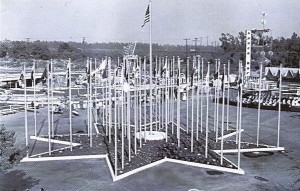


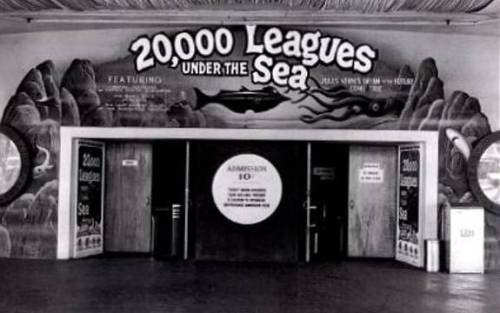
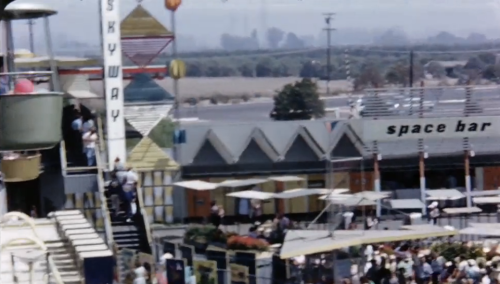
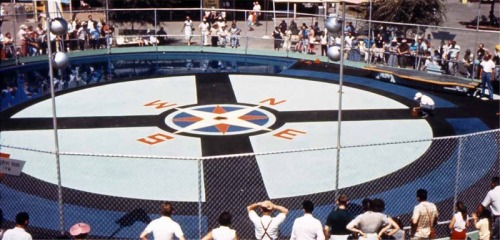
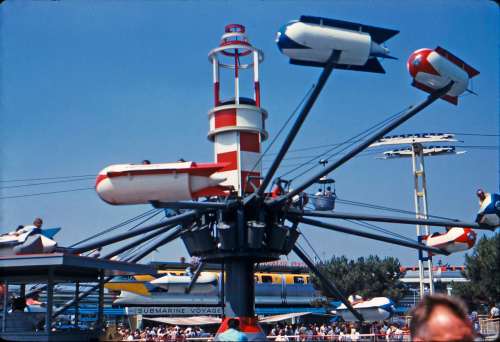

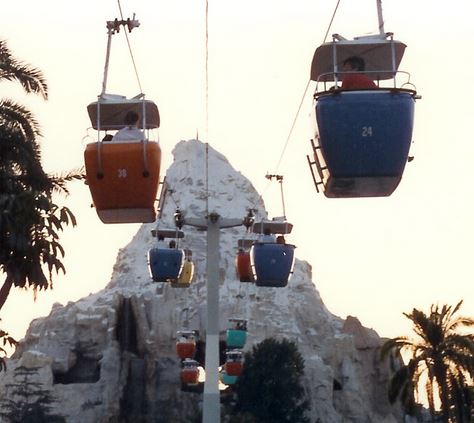
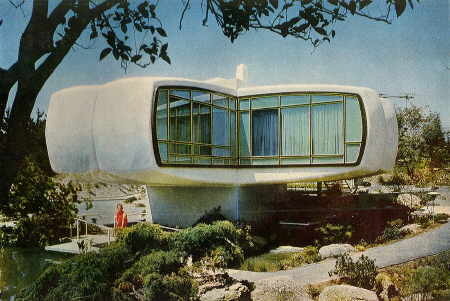
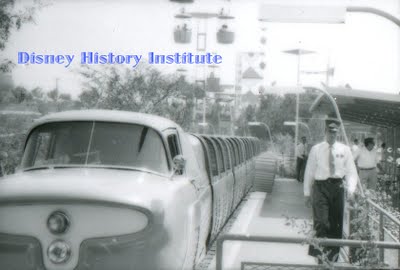
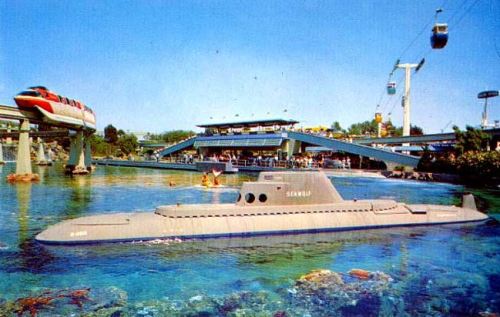



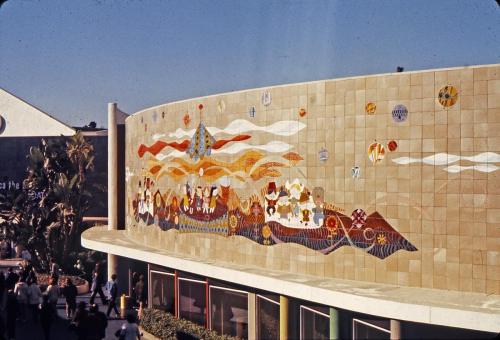
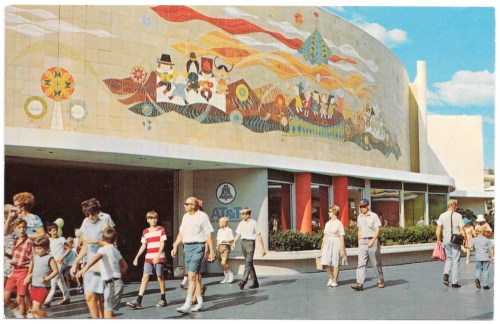
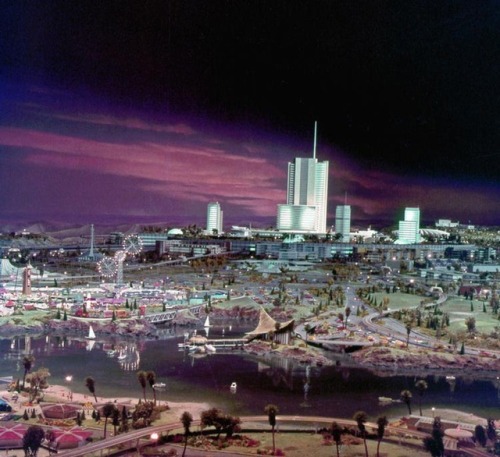


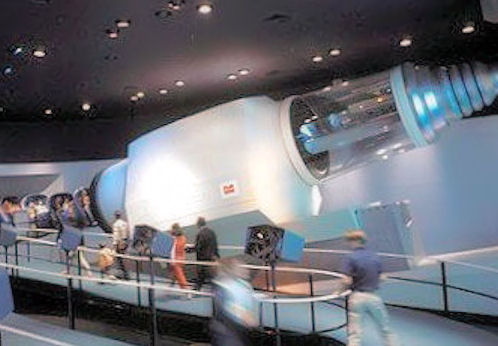




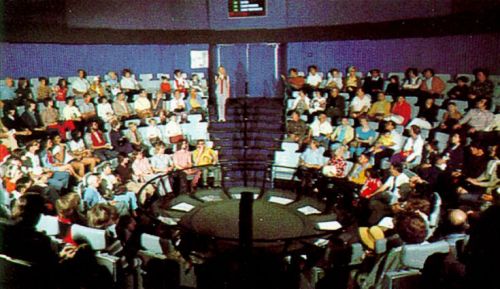
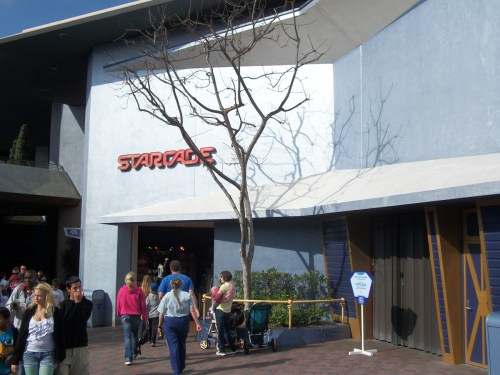
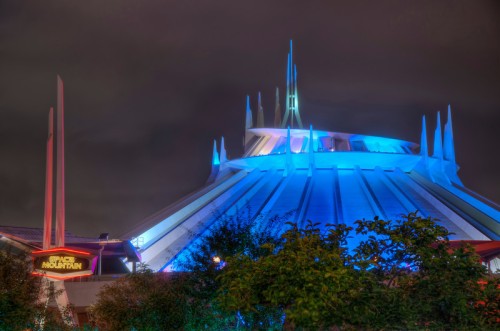




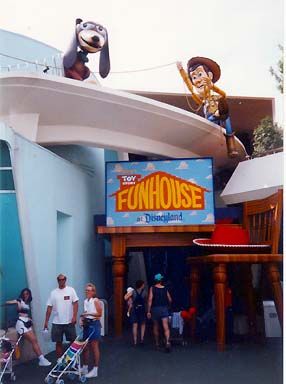


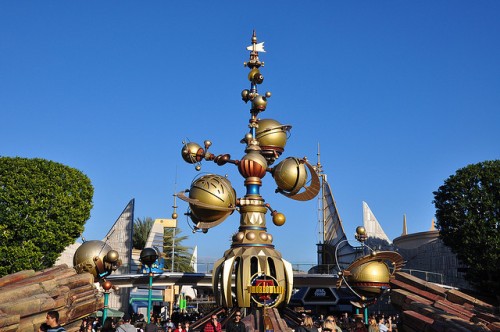


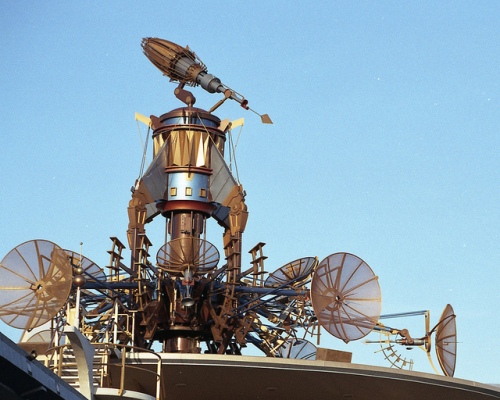

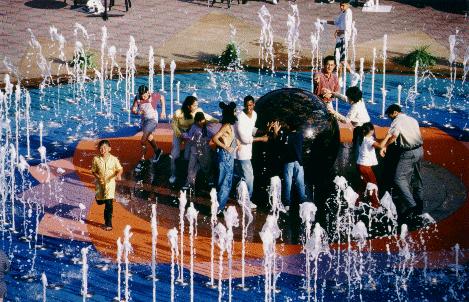




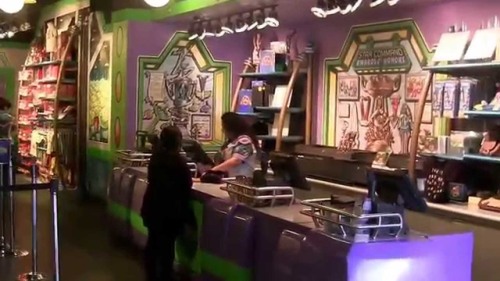

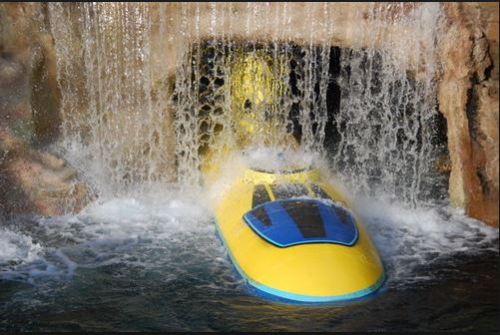
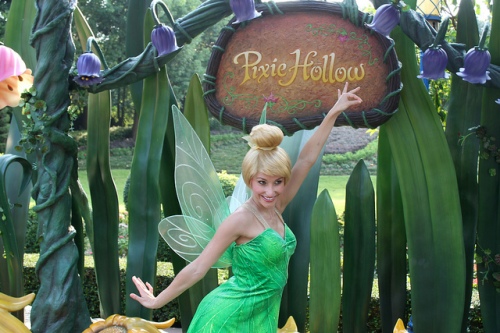
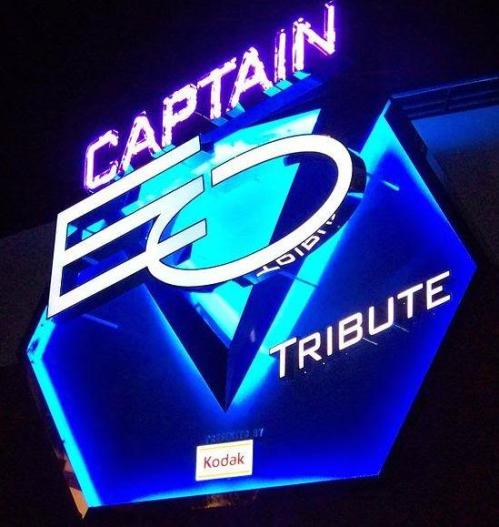


[…] of Dateline Disneyland turned their attention towards the east side of the park, and the future as Tomorrowland was given its time to shine. This land became a larger challenge than anticipated. The area was […]